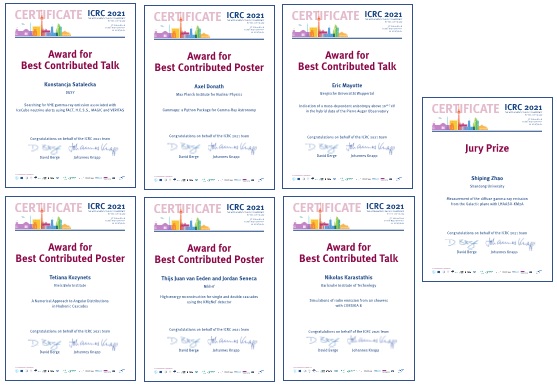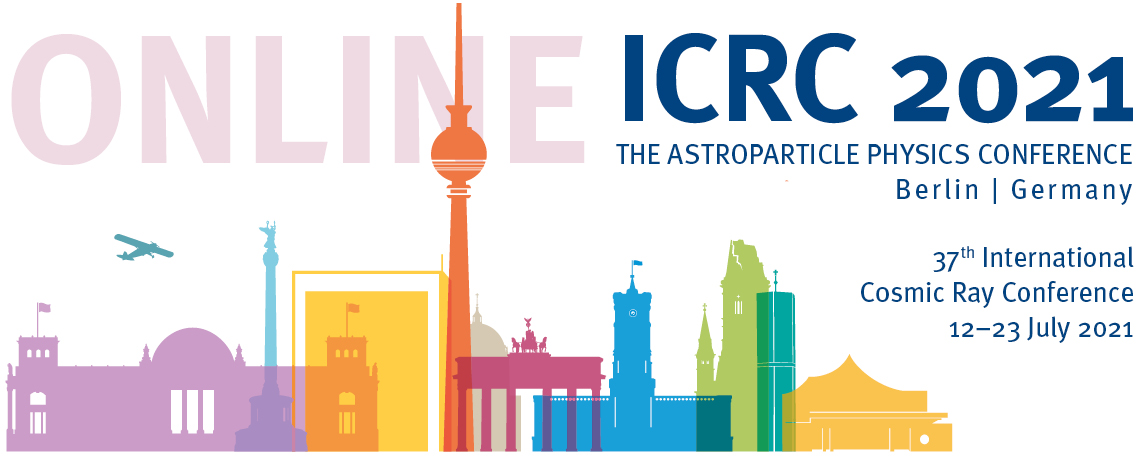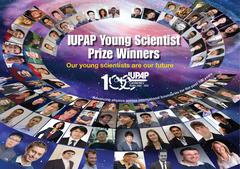Awards & Prizes
IUPAP Young Scientist Awards (2 awards)
Shakti Duggal Award
O'Ceallaigh Medal
Yodh Prize
Bhabha Medal
For all the prizes:
The lists of previous winners can be found at the website of the C4.
The deadline for nominations is 15 March 2021.
Self nominations will not be considered.
IUPAP Young Scientist Awards (2 awards)
WINNER Dr. Carlos Arguelles DelgadoHarvard University, Cambridge for "fundamental experimental and phenomenological contributions to neutrino physics through IceCube” Dr. Francesca CaloreLAPTh, CNRS, Annecyfor “Outstanding contributions to the phenomenology of dark matter”
The IUPAP Young Scientist Awards have been established in 2006 by IUPAP for the recognition of research by young scientists with a maximum of 8 years research experience following a PhD (excluding career interruptions). Any scientist working in a field of interest for the C4 Commission is eligible for these awards. The selection will be made by the IUPAP C4 Commission. Two awards, each consisting of a certificate, a medal and a cheque for Euro 1000, will be announced at the opening ceremony of the 37th ICRC on 12 July 2021.
Nominators are encouraged to consider nominating women and persons from minority backgrounds in line with the IUPAP objective of a better reflection of geographic and gender balance.
Nominations should include a Curriculum Vitae and a publication list of the nominee and a letter of support. The sponsor may also wish to ask two co-sponsors to send separate supporting letters.
Nominations should be sent to: Prof. Sunil K. Gupta Chair of the IUPAP C4 Commission (Astroparticle Physics) E-mail address: gupta.crl@gmail.com
Shakti Duggal Award
WINNER Prof. Ke Fang University of Wisconsin, Madison for “pioneering work in the fields of neutrino astrophysics and gamma-ray astronomy”
The Shakti P. Duggal Award was established in 1983 to recognize outstanding work by a young scientist in the field of cosmic ray physics. The award consists of a prize of US $1,500 to be announced at the opening ceremony of the 37th ICRC, 12 July, 2021. The winner is invited to visit the Bartol Research Institute at the University of Delaware to present a colloquium at some time during the following year. The intent of this award is to recognize and inspire young cosmic ray scientists early in their careers. The recipient will not have attained the age of 36 on 1 January 2021. Subject to this age limitation, any person from anywhere in the world who has contributed significantly to the field of cosmic ray physics including astroparticle physics is eligible for consideration. The selection of the prize winner will be made by an International Committee.
Here a Brief History of the Shakti Duggal Award can be found.
Nominations of potential recipients are now being solicited. Nominators are requested to send to the committee secretariat at the Bartol Research Institute their nominee's curriculum vitae and publication list, a supporting letter, and, if possible, copies of one or two of the candidate's most significant publications.
The sponsor may also wish to ask one or two co-sponsors to send letters supporting the nominations.
Nominations should be sent to: Prof. Jamie Holder Duggal Award Committee Bartol Research Institute, University of Delaware Newark DE 19716, USA Email: jholder@udel.edu
O'Ceallaigh Medal
WINNER Prof. Paolo Lipari University of Rome and INFN, La Sapienza for “Outstanding contributions to cosmic ray physics including neutrinos, highenergy interactions and by making complex problems accessible to nonexperts through pedagogy”
The O'Ceallaigh Medal was established by the estate of the late Prof. Cormac O'Ceallaigh and the Dublin Institute for Advanced Studies to honour "outstanding contributions to cosmic ray physics" and is awarded by the Commission on Astroparticle Physics (C4) of the IUPAP. The Commission wishes to use this award to recognize significant contributions to our field over an extended career. The selection will be made by the commission and the winner will be announced at the opening of the 37th International Cosmic Ray Conference on 12 July 2021.
Nominators are encouraged to consider nominating women and persons from minority backgrounds in line with the IUPAP objective of a better reflection of geographic and gender balance.
Nominations should include a Curriculum Vitae and a publication list of the nominee and a letter of support. The sponsor may also wish to ask two co-sponsors to send separate supporting letters.
Nominations of suitable recipients of the medal should be sent to:
Prof. Sunil K. Gupta
Chair of the IUPAP C4 Commission (Astroparticle Physics)
E-mail address: gupta.crl@gmail.com
Yodh Prize
WINNER Prof. Anthony Bell University of Oxford for “Outstanding contributions to the acceleration of cosmic rays through turbulent magnetic-field amplification”
The Yodh Prize was established in 1998 and recognizes a scientist whose research career has had a major impact on the understanding of cosmic rays. The Prize was endowed by Gaurang and Kanwal Yodh to the University of California Irvine Foundation. The awardee is selected by an international committee of distinguished scientists in the field of cosmic ray and astroparticle physics. There is no age restriction. The award consists of a prize of US $2,000 and will be announced at the opening of the 37th ICRC in Berlin, Germany, on 12 July 2021. The winner will also be invited to visit the University of California, Irvine to present a Department of Physics and Astronomy Colloquium at some time during the following year. Further information is available at this link.
Nominations will include a letter supporting the case, the nominee’s curriculum vitae, and a list of important publications. The sponsor may also wish to ask two co-sponsors to send letters supporting the nomination.
===> The deadline for nominations for the Yodh Prize has been prolonged to 30 April 2021.Nominations should be sent to
Prof Steven Barwick (University of California-Irvine)
E-mail sbarwick@uci.edu
Bhabha Award
WINNER Prof. Francis Halzen University of Wisconsin, Madison for “Outstanding contributions to Cosmic Ray physics including high energy neutrino physics through the IceCube detector”
The IUPAP-TIFR Homi Bhabha Award (Certificate, Medal and Prize) was established by the International Union of Pure and Applied Physics (IUPAP) and the Tata Institute of Fundamental Research (TIFR), Mumbai, India in 2010 to honor Dr. Homi Jehangir Bhabha, a cosmic ray physicist well-known for the Bhabha-Heitler cascade theory and relativistic positron-electron scattering, also known as Bhabha scattering. Homi Bhabha founded the TIFR in 1945 and initiated the nuclear energy program in India in 1951 with strong support from the well-known philanthropist and industrialist JRD Tata and the Government of India then led by Prime Minister Jawaharlal Nehru. Homi Bhabha initiated experimental programs for the study of cosmic ray particles and their interactions with instruments either carried aloft to the top of the atmosphere with balloons or placed in laboratories at high altitude or deep underground. The Homi Bhabha Medal and Prize consists of a certificate, a medal, an award of INR 250,000 and an invitation to visit the TIFR, Mumbai, and the Cosmic Ray Laboratory, Ooty to give public lectures there, and will be awarded biennially at the International Cosmic Ray Conferences (ICRCs), held generally in odd numbered years.
The IUPAP-TIFR Homi Bhabha Award will be given to an active scientist who has made distinguished contributions in the field of cosmic ray physics over an extended academic career. The winner of the prize will be selected by the members of the C4 and a senior cosmic ray scientist nominated by the Director, TIFR. The winner of the 2021 prize will be announced at the opening session of the 37th ICRC 2021, on 12 July 2021, and invited to visit India at a mutually convenient time thereafter to deliver two public lectures. The Director, TIFR will present the Homi Bhabha medal and an award of INR 250,000 to the winner on this occasion. The winner will be provided with reasonable travel expenses and local hospitality for the visit to TIFR, Mumbai and Cosmic Ray Laboratory, Ooty in India.
Nominators are encouraged to consider nominating women and persons from minority backgrounds in line with the IUPAP objective of a better reflection of geographic and gender balance.
Nominations should include a letter supporting the case, the nominee’s curriculum vitae, and a list of important publications. The sponsor may also wish to ask two co-sponsors to send separate letters supporting the nomination.
Nominations of suitable recipients should be sent to:
Prof. Sunil K. Gupta
Chair of the IUPAP C4 Commission (Astroparticle Physics)
E-mail address: gupta.crl@gmail.com
Best Contribution Contest
WINNER Jury Price Shiping Zhao Shandong University for “Measurement of the diffuse gamma-ray emission from Galactic plane with LHAASO-KM2A”
WINNER Best Poster Tetiana Kozynets Niels Bohr Institute for “A Numerical Approach to Angular Distributions in Hadronic Cascades”
WINNER Best Poster Axel Donath Max Planck Institute for Nuclear Physics for “Gammapy: a Python Package for Gamma-Ray Astronomy”
WINNER Best Poster Thijs van Eeden & Jordan Seneca Nikhef for “High-energy reconstruction for single and double cascades using the KM3NeT detector”
WINNER Best Talk Eric Mayotte Bergische Universität Wuppertal for “Indication of a mass-dependent anisotropy above $10^{18.7}$ eV in the hybrid data of the Pierre Auger Observatory”
WINNER Best Talk Eric Mayotte Bergische Universität Wuppertal for “Indication of a mass-dependent anisotropy above $10^{18.7}$ eV in the hybrid data of the Pierre Auger Observatory”
WINNER Best Talk Konstancja Satalecka DESY for “Searching for VHE gamma-ray emission associated with IceCube neutrino alerts using FACT, H.E.S.S., MAGIC, and VERITAS”
WINNER Best Talk Nikolaos Karastathis Karlsruhe Institute of Technology for “Simulations of radio emission from air showers with CORSIKA 8”
All conference participants were invited to vote for the best contribution
A jury composed of selected local organisers and International Scientific Programme Committee members made the final choice
The jury selected 6 prize winners (3 posters, 3 talks) from the most popular (non-plenary) contributions (by young scientists)
In addition the jury has decided to award one more special ”Jury Prize” for the most viewed contribution


